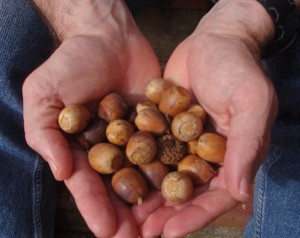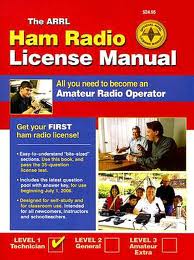 Although October’s weather has been mild and the leaves are just barely starting to come down, it feels like THE SKY IS FALLING! After an exceptionally warm and dry summer, the acorns are dropping in record numbers. (I learned that this will lead to next summer having a mice and deer population boom (due to the surplus food), followed by an overabundance of ticks that live on them.) I felt this was a good time to study up on acorns as a food source. Acorns, like other nuts, are surprisingly nutritious and containing protein and “good fat”. Acorns do have high quantities of tannins, which make them bitter and somewhat inedible as is, but these tannins can be removed with repeated boiling. The acorns can then be roasted and ground into a meal to be used in place of, or with, flour. You can even make a coffee-like substitute. Acorns are best stored as nuts, and then processed throughout the winter as needed, because the ground meal has a short shelf-life due to the high fat content. Fall is a great time for gathering “natural produce” from your local surrounds. If you are unfamiliar with wild edibles, look for a local class offered by an expert. Here are my links to: acorn processing (with recipes) and a local nature hike for wild food identification.
Although October’s weather has been mild and the leaves are just barely starting to come down, it feels like THE SKY IS FALLING! After an exceptionally warm and dry summer, the acorns are dropping in record numbers. (I learned that this will lead to next summer having a mice and deer population boom (due to the surplus food), followed by an overabundance of ticks that live on them.) I felt this was a good time to study up on acorns as a food source. Acorns, like other nuts, are surprisingly nutritious and containing protein and “good fat”. Acorns do have high quantities of tannins, which make them bitter and somewhat inedible as is, but these tannins can be removed with repeated boiling. The acorns can then be roasted and ground into a meal to be used in place of, or with, flour. You can even make a coffee-like substitute. Acorns are best stored as nuts, and then processed throughout the winter as needed, because the ground meal has a short shelf-life due to the high fat content. Fall is a great time for gathering “natural produce” from your local surrounds. If you are unfamiliar with wild edibles, look for a local class offered by an expert. Here are my links to: acorn processing (with recipes) and a local nature hike for wild food identification.
 The HAM radio class has been…interesting. No, I am not going to lie, it’s HARD! This class is put on by the local HAM radio club, using approved slides by the American Radio Relay League (the people who license you). BUT, what they don’t tell you is that this book/class/test has almost nothing to do with how to actually operate the radios. It covers the laws of usage, and the how and why of the science that make these radios work. For anyone who doesn’t have a science or electrical background, or who has been out of school for a long time, this is some hard stuff! There is nothing in the book or class that will teach me how to actually dial in and listen to people broadcasting, let alone how to actually broadcast myself. My class ranges in age from about 12 to 70 years old and we are all pretty much shaking our heads. Once we finish the class and take the test we will be licensed, but we are all going to have to join the club to get mentors to teach us how to actually operate the radios!
The HAM radio class has been…interesting. No, I am not going to lie, it’s HARD! This class is put on by the local HAM radio club, using approved slides by the American Radio Relay League (the people who license you). BUT, what they don’t tell you is that this book/class/test has almost nothing to do with how to actually operate the radios. It covers the laws of usage, and the how and why of the science that make these radios work. For anyone who doesn’t have a science or electrical background, or who has been out of school for a long time, this is some hard stuff! There is nothing in the book or class that will teach me how to actually dial in and listen to people broadcasting, let alone how to actually broadcast myself. My class ranges in age from about 12 to 70 years old and we are all pretty much shaking our heads. Once we finish the class and take the test we will be licensed, but we are all going to have to join the club to get mentors to teach us how to actually operate the radios!
 In the last month my husband and I attended our first of two gun shows together, and took our concealed carry class. If you have never been to a gun show before (my husband had not), I describe it as “Bubbas, Bellies & Bullets”. They have so many rows jammed with tables that I literally had to squeeze in between all the big bellied bubbas to even walk. As a Marine my husband is familiar with a number of interesting weapons, but he had never seen so many interesting people in such a confined space. I finally explained to him that gun shows are to the NRA what ComiCon is to gamer/sci-fi nerds. Gun shows are the ultimate showplace for our right to bear arms. We spent our time at each of the shows looking at smaller handguns that I could use for concealed carry. What I discovered was that the bursitis in my elbow prevents me from comfortably holding any weapon over about 1.5 lbs., thus limiting my options. Like everything else, we will be taking our time, heading to the range to try them out, to find just the right weapon.
In the last month my husband and I attended our first of two gun shows together, and took our concealed carry class. If you have never been to a gun show before (my husband had not), I describe it as “Bubbas, Bellies & Bullets”. They have so many rows jammed with tables that I literally had to squeeze in between all the big bellied bubbas to even walk. As a Marine my husband is familiar with a number of interesting weapons, but he had never seen so many interesting people in such a confined space. I finally explained to him that gun shows are to the NRA what ComiCon is to gamer/sci-fi nerds. Gun shows are the ultimate showplace for our right to bear arms. We spent our time at each of the shows looking at smaller handguns that I could use for concealed carry. What I discovered was that the bursitis in my elbow prevents me from comfortably holding any weapon over about 1.5 lbs., thus limiting my options. Like everything else, we will be taking our time, heading to the range to try them out, to find just the right weapon.
What did you do to prep this month?

Actually the FCC licenses you, the ARRL just the national group for HAM operators. It is still important to know the theory behind the radio and more important (for the tech class) know the rules of the air. Otherwise you could face large fines and/or loss of license. As for using the radio, each radio is different so the best would be to find someone that has the same radio as you and learn from them, thus the reason for HAM clubs.
As for preps this month. I finally built my generator cord for 1/2 the price of buying a prebuilt. Took awhile to get all the pieces as I only bought the stuff while on sale. Albeit, it won’t be too useful until next year’s project of replacing the electrical load center (old enough to not have a main breaker) that also has a built in transfer switch. But slow and steady wins the eventual preparedness race.
David, Thanks for the clarification. I guess you can sense the frustration for us newbies! I completely agree with the slow and steady (and on sale) approach to prepping. Having just survived Hurricane Sandy, I can tell you that all the stores sold out of generators (and gas cans, and water, etc.) prior to the storm. I am forever amazed at people who wait for an imminent disaster before stocking up!